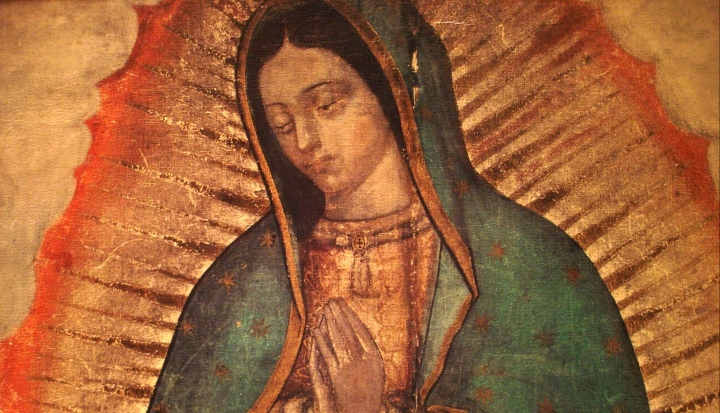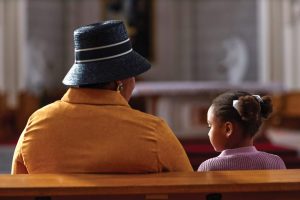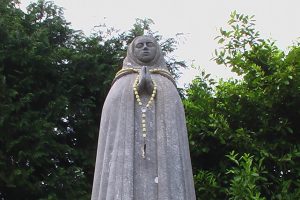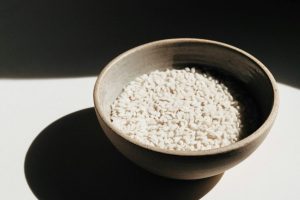To understand Our Lady of Guadalupe–the powerful story of the 16th-century apparition of Mary to the Indian Juan Diego outside what is now Mexico City–Jeanette Rodriguez says we must first enter into the experience of near-annihilation that the indigenous people faced at the hands of the Spanish invaders. It was in response to their agony that Our Lady of Guadalupe spoke her message of loving presence.
Since that time–and for people today–Guadalupe has been a “prism”: some see her simply as an image of Mary, while others see her as showing us the maternal face of God or even an image of the Holy Spirit. However her devotees interpret her, Rodriguez believes Guadalupe reminds us of God’s unconditional love and challenges us to make God accessible to all people.
Rodriguez, chair of the Religious Studies and Theology Department at Seattle University, has explored the meaning of Guadalupe in Our Lady of Guadalupe: Faith and, Empowerment Among Mexican-American Women (University of Texas Press, 1994) and is the author of Stories We Live/Cuentos Que Vivimos (Paulist Press, 1996).
What attracted you to Our Lady of Guadalupe?
As an Ecuadorian American, I grew up with the Marian image of the Sorrowful Mother, and I knew at a very young age that I did not want to be a “suffering mother.” Even though I had a great devotion to Mary, I wasn’t willing to embrace the image that I was raised with except as one who could identify with the oppressed or suffering.
When I went to Berkeley for my doctorate, the environment was so undiverse that I decided I needed to make contact with the Latino mission, and so I wound up working with the campesinos. I noticed that they had a great devotion to Our Lady of Guadalupe, and I was very taken by the affective bond they had with the image of her. And so I observed and I started to read, and I went to Mexico to do my investigation.
Have your studies of Our Lady of Guadalupe also increased your own devotion to her?
When I was writing my book, I was diagnosed with a serious illness, and for three years, I was very sick. There were two things I wanted to do before I deteriorated: I wanted to finish the book, and I wanted to leave a legacy for my children. I wanted my children to know that death would not separate me from them.
I decided to go back to the Basilica of Our Lady of Guadalupe, to which I have made many pilgrimages. I usually carry a little notepad, and when people find out I am going there they often ask me to make sure to pray for their intentions, which I then write down. Recently, for example, I went to the passport agency to get a passport for my son because I’m taking him to the basilica in the near future. When I told the woman at the counter, she said, “When you go to the basilica, would you please thank Our Lady of Guadalupe for me for a successful operation,” I said, “Yes, I’ll do that.”
So when I was diagnosed with my illness and went to the basilica, this particular time I prayed that Our Lady would always protect my children. But I didn’t pray for myself. I didn’t ask for healing, didn’t ask to be cured. When I came back home and everybody asked, “Did you pray to be cured?” I said no, and they all got upset with me. But then when I got back, my lab results were normal for the first time in three years.
I was able to surrender, to say to Guadalupe, “You more than anyone know what it is that I need or want. Just give me the strength to be open to that.” I really feel that she is a gift that the Mexican community has given to me, and I really attribute the gift to them.
What do we need to know to understand Our Lady of Guadalupe?
Number one, the historical context. The 16th-century clash of cultures between the Aztecs and the Spaniards involved different understandings of some fundamental concepts–in particular land, the greatest sins, and time.
The Spaniards felt that the earth had been given to humans by God to claim and use for their own good. The Indians held the earth and space to be sacred, believing it belonged to the gods. Humans had to live in harmony with it.
For the Spaniards, the most important value was salvation of the soul through individual character, both in making a name for oneself and in the hereafter. They understood their salvation came through the sacrifice, death, and Resurrection of Jesus Christ. The Indians’ most important value was the salvation of the group and its wellbeing and preservation. Indian religion valued the individual only for his or her contribution to collective activities designed to preserve the cosmic order.
For the Spaniards, the greatest sins were heresy, apostasy, and idolatry. The greatest sins for the indigenous people were greed, perversion, and not following the elders–turning away from the ancestors.
It was bad enough for them to be enslaved, to see their land taken away, their homes destroyed, their women raped, and their children killed–but for them the worst part was when the Spanish tried to tell them that the gods that they had worshiped were not true. For a people who had never made a decision without consulting their gods, to be told that what their ancestors had told them was not true was just too devastating to bear. They wanted to die. In the transcripts of missionaries and priests, you find the people expressing this sentiment, “If this is true, then please let us die. If the gods have abandoned us, we don’t want to live.”
How does this historical context relate to the Guadalupe story?
It’s really important to understand those clashes because those same conflicts are still occurring today. This history is a metaphor for understanding the questions and the struggles, the pains and the joys of being human. Otherwise we reduce the image of Guadalupe to a Mexican cultural phenomenon as opposed to something so powerful that it’s manifested in a particular culture, transcends cultures, and really touches all who appreciate it.
Whenever we encounter what we think is “other”–black, white, Spanish, Indian, homosexual–we should ask what contribution they make to our understanding of what it means to be human. The issues are the same today as they were when 16thcentury Spaniards questioned the humanity of this “other,” the Indians.
Unless people come at and try to understand the Guadalupe story from the situation that it emerged out of, they’re not going to get it.
How does the Guadalupe story speak to this clash of cultures and the challenge to understand the “other”?
Out of all the devastation the Indians faced, Guadalupe says to Juan Diego, “I’d like you to build me a casita–a ‘house,’ a ‘home’–here so that I may show forth my love, my hope, my compassion, my defense of you, to all of you, to all the inhabitants of this land, to all of you who call upon me, love me, and trust me. I hear your devastation and your suffering and your pain, and I will respond.” All she says is, “I’m your Mother who will love, help, defend, and protect you.”
And whom does she say it to? She doesn’t say it only to the Spaniards or to the Indians, but she says it to all the inhabitants of this land. Although the world may reject us, God gives us a place in the world. I see her as that promise of being given a place in the world, of having someone to talk to or to understand.
What does Guadalupe have to do with cultural differences today, especially between Latinos and Anglos?
For some Latinos, the Guadalupe story is the lifeline to their culture, their homeland. I remember a story my mother told me about when she first arrived in the United States. When she got off the plane–it was one of those planes that had bleachers, not airplane seats–she said that the minute her foot touched the earth, the land, she felt like all the blood drained out of her body. For some people, the Guadalupe story is the connection to their past and culture.
We here in the West struggle with spiritual poverty. I think the reason Americans are so spiritually deprived is because they’ve lost their way and don’t know how to access spiritual connections at a deep level. A lot of the transmission of faith was through the family. How can you expect to talk to a people about community when they do not have that experience culturally or religiously? You can’t give what you haven’t got. So the challenge then is how to create the community we talk about but don’t give people an experience of.
What could the Latino culture teach other Americans about community?
In Latino culture, we have a lot of different community rituals, like the Day of the Dead. My family celebrates that holiday more than almost any other. My children know we gather with our community, we build our altar, people bring pictures of their loved ones, and we share the legacy of those loved ones. It’s really the power of ritual being able to open the portals of time so that for this one night, you are very conscious of the people who have gone before you, you’re conscious of the people who you’re with, and you’re conscious of the people who will follow you.
And so children are not afraid of death and are affirmed that death is not enough to separate you from the people you love. People in this culture are so afraid of death because they’re so cut off from community.
But who are the facilitators, who are the “priests” facilitating that kind of wisdom? People want to have leaders who can make mystery evident, who can draw us into mystery. I’m talking about professionals trained in theology, liturgy, or ritual.
When people have a fiesta in a parish, the person who gives the speech is no bigger, no better than the woman who’s making tortillas–as a matter of fact, she’s probably got top billing. Everybody has a job to do. And the challenge to pastoral ministry is that people don’t know the difference between identified leaders and the real leaders, and they’re not willing to do good ministry anymore when people come to them. They dispense services as opposed to a way of life.
What other differences do Latinos and Anglos have?
The most healing moment is when you’re able to stand before someone in your brokenness and be accepted. Go to any church in Central America and you’ll find that most people pray out loud–very rabbinic, by the way. You listen to their prayers, and what you hear is heart-wrenching and full of gratitude. In many ways, the American mentality is wonderful for its innovation and creativity but devastating in terms of its ability to accept vulnerability or intimacy, or risk life or passion.
During Holy Week, for example, in American culture we’re very quick to get to the Resurrection because we’re very uncomfortable on Good Friday. Holy Thursday is a big deal–everything happens on Holy Thursday–and then on Good Friday you have the Passion and maybe the Stations of the Cross.
Now, what happens on Saturday? Nothing. But you go to Latino communities and they’ll be in church on Saturday. Why? Because they’re keeping the Virgin company. This notion of accompaniment is something we’ve lost. What I love about Marian devotion on the part of Latinos is that it’s reciprocal. They’re sympathetic because she lost her son, and they know she understands what it’s like to lose a son, maybe not to the cross, but to drugs, to poverty, to violence, to illiteracy.
For a different reason most of my students have had major conversions when studying Guadalupe because in their own way, they don’t have a place in the world. They don’t experience racism or poverty, but they do experience a different kind of poverty, a spiritual poverty.
In what ways is the Guadalupe story a corrective to the dominant Catholic culture?
Guadalupe resurrects a notion of a much more loving, an unconditionally accepting God. Even the other Marian images–I don’t mean to critique them, but when I read their messages, they don’t grab my heart the way the Guadalupe one does because they’re conditional. I don’t know if you’ve seen the document on Fatima, but it’s scary.
Guadalupe’s message is so transformative because it’s so accessible. How could you not respond to someone who offers you love, compassion, and help-when someone promises you that they’re going to be there to hear your sorrows and pains?
In that sense, I think she resurrects or reminds us of that unconditional love of God. Her presence among the poor once again reminds us of the original intent of the biblical God of liberation and the message of Jesus as I understand it. To me it’s much more liberating.
Do you see a problem with people using Guadalupe for their own purposes or agendas?
You have to make a distinction between the original intent of Guadalupe and what they’ve done to her. A lot of women critique Guadalupe not because of who and what she is, because they don’t know that. What they know is what the clergy have told them about her: “Be like Guadalupe, quiet and gentle.” No wonder they’re rejecting her.
But I don’t think that’s the original intent when you read the story. There’s nothing passive about saying, “Go tell the bishop what I just told you.”
I’ll give you an example. In one of the dioceses where I was working, people were asking the bishop permission to use the image of Guadalupe for their prolife campaign. A question that emerges out of this issue is accessibility. Would using Guadalupe in this way enhance people’s accessibility to her and to God?
To what extent do we make God more accessible to people or less accessible? If people can no longer come to God through God the Father, then you better have another path or you’ve just broken that person’s ability to access God. Our God needs to be bigger than us, bigger than the Catholic Church, big enough so that God can be accessed. In a way, I think the story of Guadalupe is the challenge of how do we clear the way so people can come to God?
Is Guadalupe more than a manifestation of Mary?
I don’t perceive Guadalupe as solely Mary, especially Mary at the Cross. I do tend to lean more toward her being even a maternal face of God. I have a more pneumatological understanding–seeing her in terms of spirit–but that’s too heavy for some people to deal with. It’s just starting to be talked about now in circles that she’s much more representative of the Holy Spirit.
I asked the women I talked to as part of my research, “Do you think that she’s more important than God?” and they say,”Oh, no.” But if you say to them, “When you pray, whom do you pray to?” they say, “Guadalupe, Mary.” I say, “Why would you go to her with things that you would not go to God with?” “Because she’s a woman, she understands.”
This is why I like to look at Guadalupe as a prism. For those people who look at her and come to her as Mary, no problem. There will be other people who will come to her as the maternal face of God, and still others–like a Jewish woman I interviewed who claims to be a Guadalupe devotee–for whom Guadalupe comes through the Spirit. And why would I want to take that away from any of them?
Instead of putting Guadalupe in a box, I would put her in the category of a unconditional and grace-filled gift to the people. What she was able to do was reconcile two groups of people that had absolutely nothing in common and could not come together. Looking at the contemporary situation of conflict, can she still play the role of reconciler personally and physically for those of us who struggle with not being one or the other?
What do the people who go to the Guadalupe shrine bring?
They bring their pains, they bring their sorrows, they bring their worries, they bring their gratitude, and they bring their promises.
I’ll tell you this story. I was with a Spanish priest, and he was showing me around the basilica and there was this old man on the side. The priest said, “Hombre, what are you doing here?” And the old man said, I want to pray to the Lady.” The priest replied, “Well, I don’t see you praying.” And the old man admitted, “Oh, Father, I don’t know how to pray.” So Father said, “OK, here’s a prayer book.” The old man said, “I don’t know how to read,” and then the priest starts yelling at him, “Well, what are you doing here?” And the old man said, “You know, it’s just enough for me to look in her face.”
This article first appeared in the December 1999 issue of U.S. Catholic (Vol. 64, No. 12, pages 18-22).
Image: Flickr cc via Sacred Heart Cathedral Knoxville














Add comment